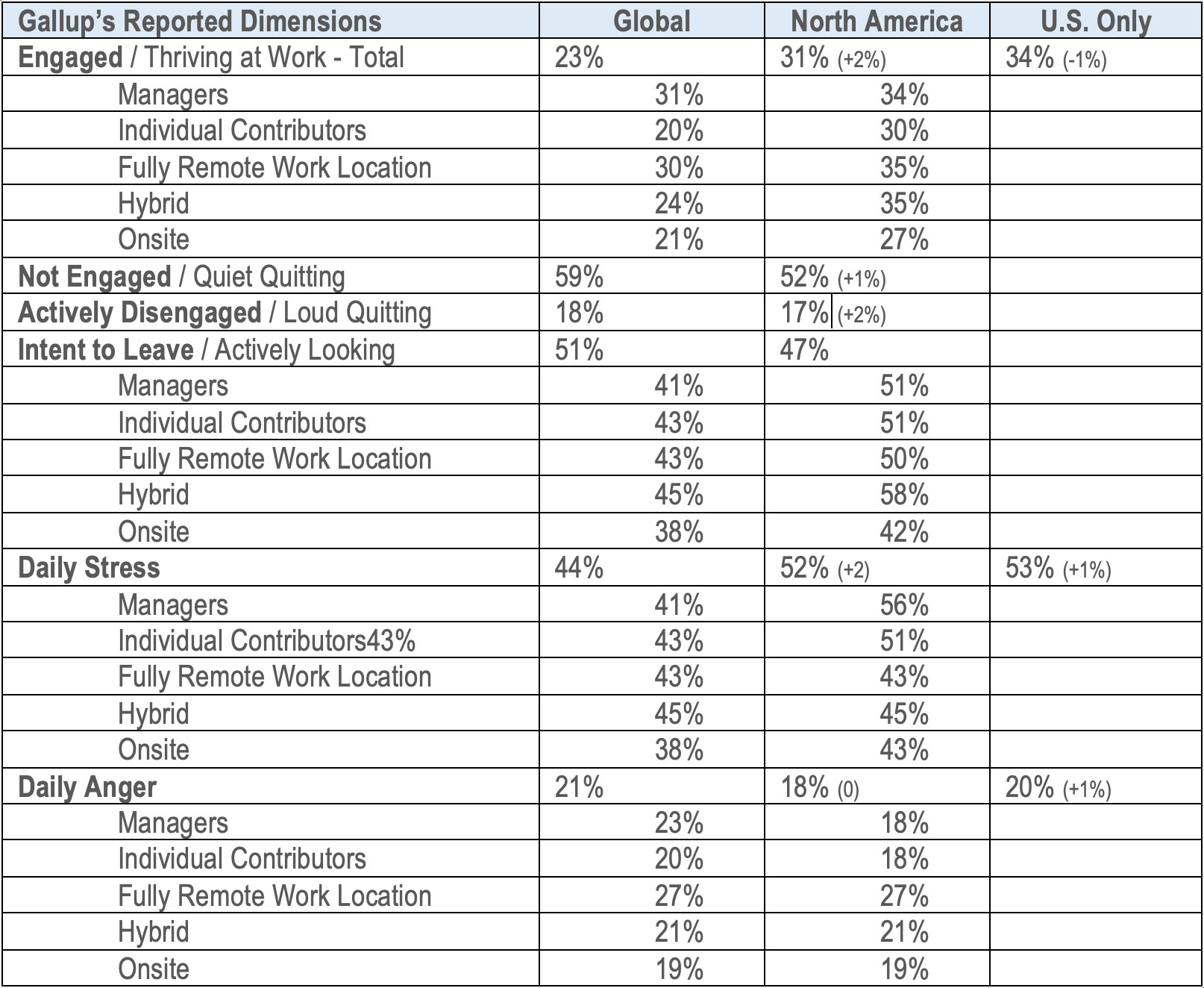 With more than 1,000 employed participants (ages 15+) from each of the 160+ countries that have participated in the survey process since 2005, Gallup completed its data gathering between April 2022 and March 2023, and just published its most recent study on the global workplace. Gallup’s 99-page report State of the Global Workplace 2023 Report: The Voice of the World’s Employees provides some salient insights including:
With more than 1,000 employed participants (ages 15+) from each of the 160+ countries that have participated in the survey process since 2005, Gallup completed its data gathering between April 2022 and March 2023, and just published its most recent study on the global workplace. Gallup’s 99-page report State of the Global Workplace 2023 Report: The Voice of the World’s Employees provides some salient insights including:
- Focus on development of top talent and managers.
- Daily stress in engaged employees = 30%, while actively disengaged employees = 56%.
- Employee engagement has 3.8X the influence on stress over work location.
- Low global employee engagement has a cost of $8.8T… equivalent to 9% of the global GDP.
- Intent to leave their job is now 51% global, including 43% of engaged employees and 61% of those actively disengaged.
- Quiet quitters (59% globally) want culture/engagement change (41%), pay & benefits enhancement (28%), and improved wellbeing (16%).
Gallup’s data also tells us at The HRC:
- People expressed an intent to leave their roles 51% globally and 47% nationally, which is of significant concern and confirms other studies’ recommendations for intensified efforts by leaders and managers to focus on organizational culture, leadership development, management development, as well as employee engagement and experience.
- After several tumultuous years, it’s unlikely the “talent wars” will taper off. Globally, 53% of employees said they believe it’s currently a good time to find a job, which is close to the 2019 record of 55% of respondents. The percent of people expressing an intent to leave, combined with the impression that it is a positive climate in which to find a job, reaffirms that retention may continue to be a challenge for many organizations.
- The engagement level reported in the Americas is surprisingly high. It’s reported to have increased 2% since Gallup’s last report. However, engagement declined by 1% in the U.S. while people reporting experiencing “daily stress” and “daily anger” increased at the same rate. So, it’s critical to not to conflate engagement and happiness. Engaged employees thriving at work still report daily stress and anger; however, as “psychological owners,” they are key to performance, innovation, and productivity. Engaged employees are not always “happy,” but are highly involved and productive.
- Data surrounding work locations is a bit surprising and more positive for organizations exploring the revitalization of onsite work. It appears that while some reports of polarization between leaders and employees regarding onsite work, Gallup’s data indicates fully remote or onsite (vs. hybrid) work arrangements appear to reduce stress and intent to leave, even when employee engagement is lower. The data also indicates significantly higher daily anger levels in those who work remotely. This is clearly something each organization may find useful to explore in order to grasp both internal and external causation.
- The greatest productivity growth that organizations may find may be among the “quiet quitters” who are at work but not necessarily taking ownership of their work. Rather than allowing them to follow their intent to leave, re-engaging “quiet quitters” who are waiting to be coached, motivated, and inspired, should be seen as a pathway toward productivity gains.
- Understanding the differences between employees who are not engaged and “quiet quitting” and actively disengaged employees who are “loudly quitting” can help guide engagement interventions and prevent the accomplishments from engaged employees from being undermined by truly disengaged employees.
Our abridged reporting of Gallup’s data is reported below:

To receive your copy of Gallup’s full report, go to: www.gallup.com/home.aspx.
By Regan MacBain Traub, CPC & T.Scott Cawood, PhD, EdD, Organization Engagement & Sustainability Practice Leader







